Having now actually finished all of my Japan Winter Tours for this season, I’m back in the studio and ready to start sharing our experiences from the two trips.
We started our journey as usual, with a bus ride from our hotel in Tokyo, over to Yudanaka, in the Nagano Prefecture, where we walked the thirty-minute snow trail into the Monkey Monkey at Jigokudani. In recent years there hasn’t been a lot
Snow Monkeys
You can get a feel for the snow in this first photo for today, as a monkey showed aggression to another,

Still In Love with the Canon EOS R
As I mentioned in my review of the Canon EOS R in episodes 650 and 651, I shot pretty much everything in this years winter tours with the EOS R, and as I shot this image I was still getting used to the idiosyncrasies of Canon’s first full-frame mirrorless offering.
I am happy to report though, that as of the beginning of March 2019, I’ve now shot around 17,000 images with the EOS R, and I am still 100% in love with this camera. It has been so much more than I had expected, and even more of a camera than I’d hoped for. I’ve now decided to sell one of my two EOS 5Ds R bodies, and I’ll save the money from that to put towards the 5Ds R Mark II, which I am now really hoping will also be an RF Mount mirrorless camera.
Galloping Snow Monkeys
The biggest thing that has taken some time getting used to with the EOS R is that even in the high-performance electronic viewfinder mode when you are shooting in burst mode, you no longer see the fluid movement of your subject in the viewfinder. You essentially have to track a moving subject based on a series of still images, so you are almost looking at a stroboscopic representation of reality.
It does work though, and although I occasionally missed photos that I would probably have got with a DSLR camera, the other benefits such as being able to see your exposure and live histogram right in the viewfinder, in my opinion, far outway the demerits of the EOS R.
Real Snow Monkeys
On our second day in the monkey park, it snowed heavier than I’ve ever known it to while we were actually in the park, and it was an amazing day! I have been there when it snows, many times, but this day was just something else.
You can hopefully get an idea of how heavy the falling snow was, from the amount of it stuck to this snow monkey’s fur. Composition-wise, I briefly toyed with the idea of making this a shorter crop, maybe 4:5 aspect ratio, but decided to stay with my original framing, because I think having the swath of snow at the bottom of the frame in this photo helps the viewer to understand that the monkey is high up. You might not be able to see that he was looking down at me from a hill, but the sense of height probably comes across because of the snow bank at the bottom of the frame, so I decided to leave it in.
Exposure Considerations
For the Snow Monkeys, I generally shoot stationary ones such as in the previous image with between a 320th and a 500th of a second exposure. For shots like the one before that where they are running around, I try to get a shutter speed of between an 800th and a 1250th of a second. To achieve this, I increased my ISO to around 2000 or higher when necessary.
My aperture will be between f/8 for a single subject and f/11 or even f/14 if there are multiple snow monkeys in the frame that need to be relatively sharp. And, of course, I was
It’s this control over the exposure that enables me to get beautiful white snow with texture in it, and because I set my exposure in manual mode, I don’t have to mess around with exposure compensation as the darker subjects take up more or less of the frame.
This is also why I am able to capture things like the subtle shadow of this snow money leaping from a tree stump. If you find that hard to see, or can’t really see the texture in the snow, then your monitor may be set too bright. It’s important to darken down your display as part of a calibration process, otherwise, subtle details like this can be missed.
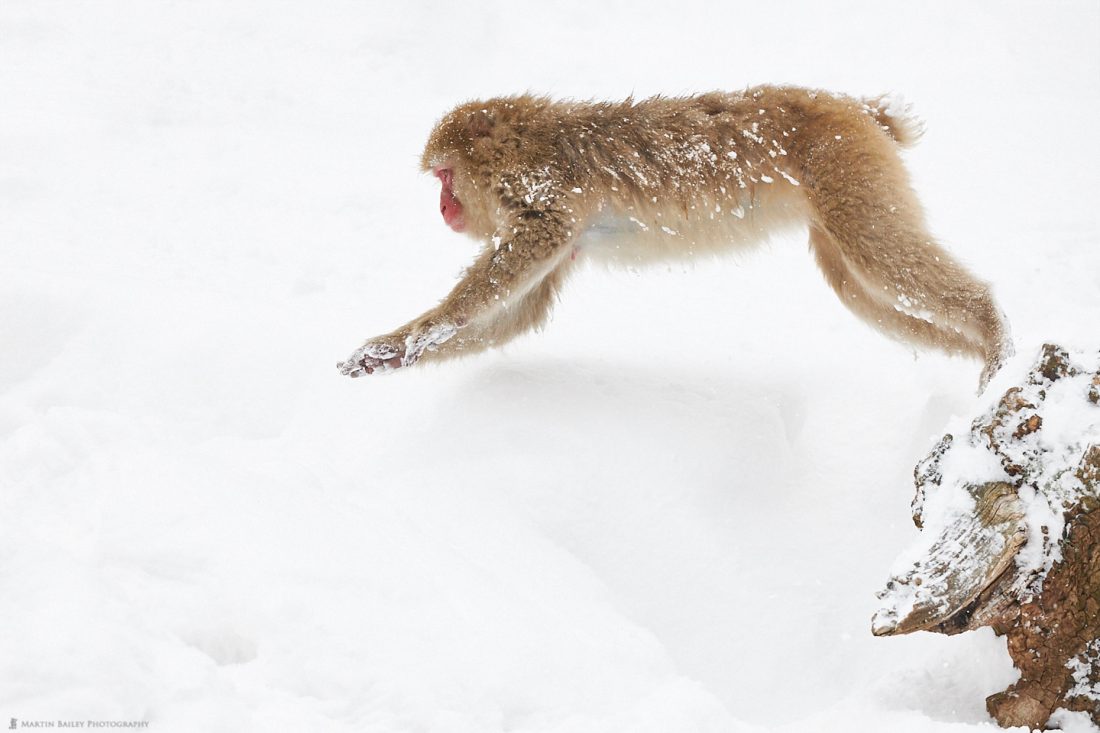
Red-Crowned Cranes
It didn’t snow on our third morning with the Snow Monkeys, and although I have a bumper crop of images from this very productive visit, we’ll move on now to day four of the tour, as we fly up to Hokkaido and start our two days photographing the beautiful Red-Crowned Cranes.
We weren’t so lucky with the snow at the cranes though. It’s becoming less and less common for it to snow while we are with the cranes. I’m actually just happy that we have a full covering of snow on the ground most of the time now, although I do wish for falling snow still. It didn’t happen on any of the days we visited this year though. As you can see from this photo though, when there isn’t fresh snow, the ground can be very heavily textured.
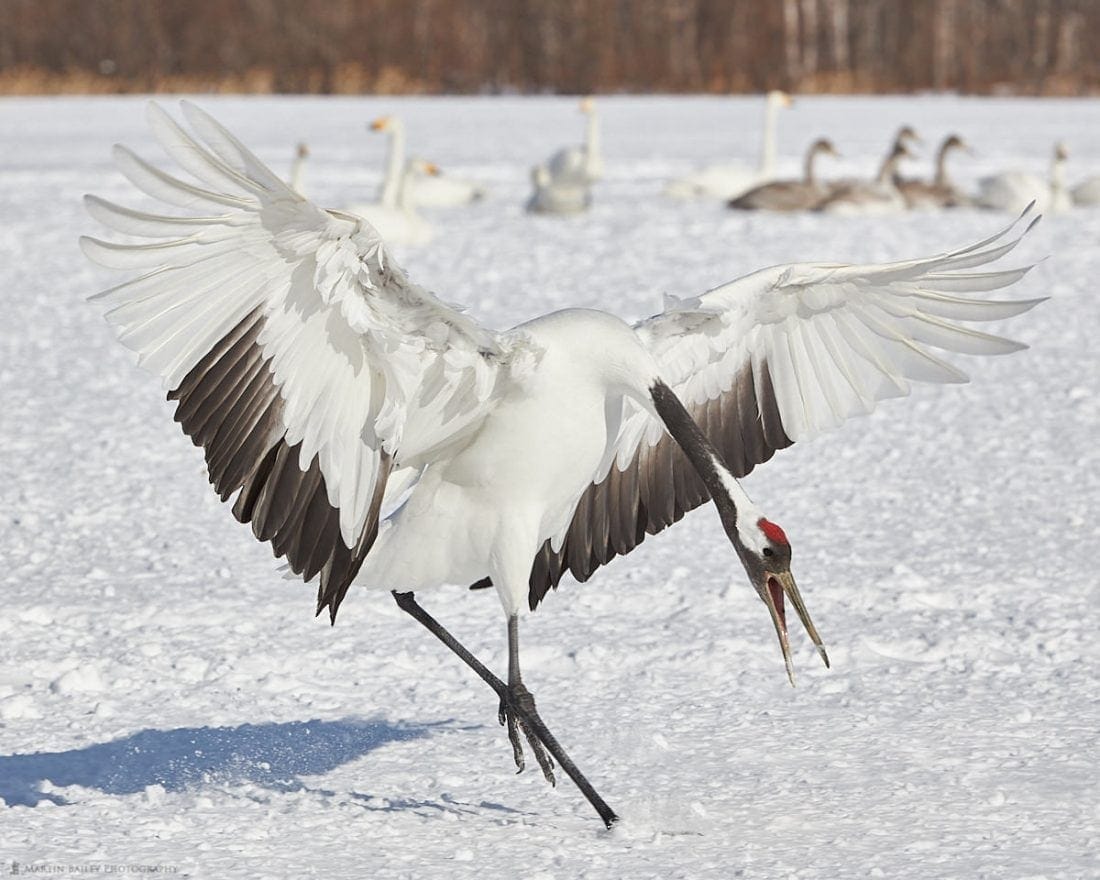
I’m still relatively happy with this photo, as it shows the beautiful detail of the ruffled feathers of the crane, as well as the pose you will often see these birds do as they land. Because the cranes often land behind other cranes, I was also somewhat happy to be able to photograph this one, that landed a little closer, and in front of the other birds, for a change. Of course, the birds in the background of this shot, are Whooper Swans, which we move on to photograph after our two days with the cranes. I was using a shutter speed of 1/1250 of a second here at ISO 500, and an aperture of f/11.
Crane Flyover
The only time I used my Canon EOS 5Ds R during the tour was as my second camera while we were with the cranes, because they sometimes fly over our heads as they leave the crane center, and you can see that in this next image.

We were lucky to get a nice sky while at the cranes though, as you can see, and this shot happened to have the crane lined up nicely with most of that stretch of blue between the clouds, which I thought was nice.
Catchlight Help
I’ve adjusted the shadows and clarity sliders in Capture One Pro to help bring out the detail in the crane, but there wasn’t much of a catchlight in this crane’s eye, due to the angle of the head. I zoomed in on the image though and saw a very faint catchlight, so I used an Adjustment brush to draw over it and then increased the exposure creating an almost false, but very convincing catchlight in the crane’s eye. Unfortunately, you probably can’t see the catchlight in the web version, although it is visible in the eBook article that accompanies this post, available to all MBP Pro Members.
Ural Owl Duo
After spending most of the first day in Hokkaido with the cranes, I took the group to a location where there is a tree that often has one or sometimes two Ural Owls, and on this day, we were lucky enough to get the latter as you can see in this next image.
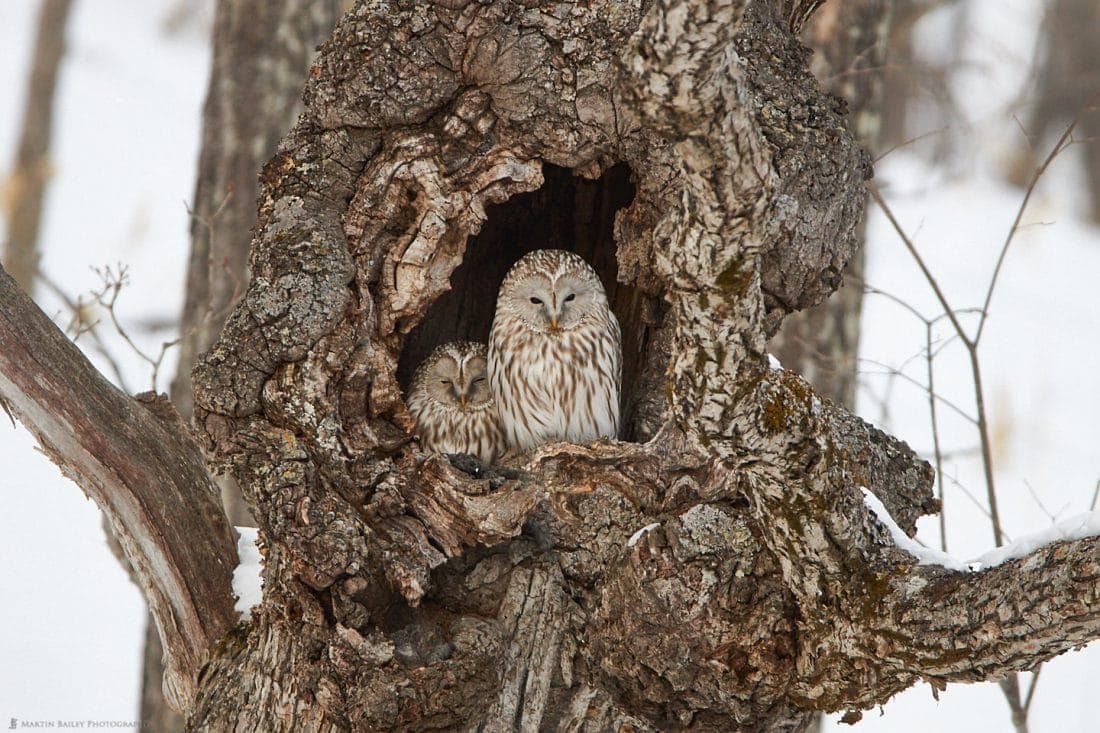
These are beautiful animals, but because of the bad behavior of many photographers that try to photograph them, the local authorities have cordoned off an area to shoot from that is quite a distance from these owls. That’s fine, and at least the owls are staying in this nest because they aren’t quite as bothered as others, but it does mean that you need a very long focal length to frame these owls like this.
I shot this with my 200-400mm lens with the built-in 1.4X Extender engaged, and an external 2.0X Extender fitted, giving me a focal length of 1120mm. Needless to
Three Cranes Take Flight
The following morning, we made our first visit to the Otowa Bridge, which as I’ve mentioned before, translates to the “Sound of Wings” Bridge, which I find simply beautiful, especially as it’s in the town of Tsurui, which means “Cranes are Here”. How cool is that!?
This is the location where we need it to be below around -16°C or 3°F, with little to no wind, and a bit of humidity, to make the trees go white with hoar frost, and hopefully some nice mist on the river. On the two mornings that we visited on this trip, it was -23°C and -25°C, which is -9°F and -13°F respectively, and this is actually a little bit too cold, as the mist was at times too heavy to even see the cranes.
Luckily though, there were times when the mist cleared enough for us to photograph the cranes, and at one point, we were really lucky to have three cranes fly away from the group. This isn’t common so early when it’s this cold, as the cranes need to warm up a little before they can fly, but someone must have been smiling on my group on this particular morning.
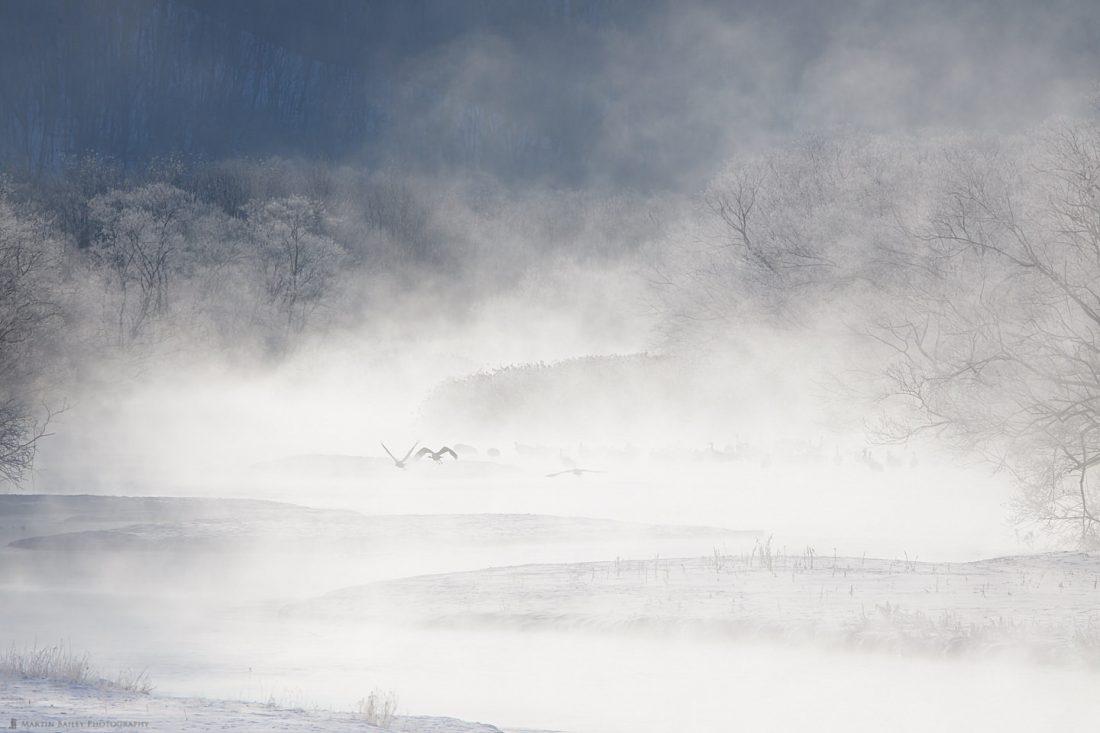
Even though we were able to see the cranes, I used a Luma Range mask in Capture One Pro to select the three cranes in
Red-Crowned Crane Preening
After breakfast, we went to the Akan Crane Center again for most of the day, and once again, it was a bright, mostly cloudless day. On days like this, although I still enjoy flight shots, the birds standing in the snow show quite a lot of texture, as we saw earlier, so I tend to spend a lot of time zoomed in very tight on the nearby cranes, doing what I call studies or almost portraits of these beautiful birds, as we can see in this photo.
I just love the detail that we can see in this kind of photograph, and also how the white of the bird almost merges into the white snow in the background. I actually have a few photos of dancing cranes from the second trip that are so similar in tone between the cranes and the background that it’s hard to see where one ends and the other starts, but I’ll share that in a few weeks time.
Crane with Birch Trees
In the middle of the afternoon, I took the group over to a different location, where we were able to photograph the cranes flying over a prettier background, with some lovely white birch trees, which make a nice backdrop. With the sun at our backs, we also get really nice catchlights in the eyes.
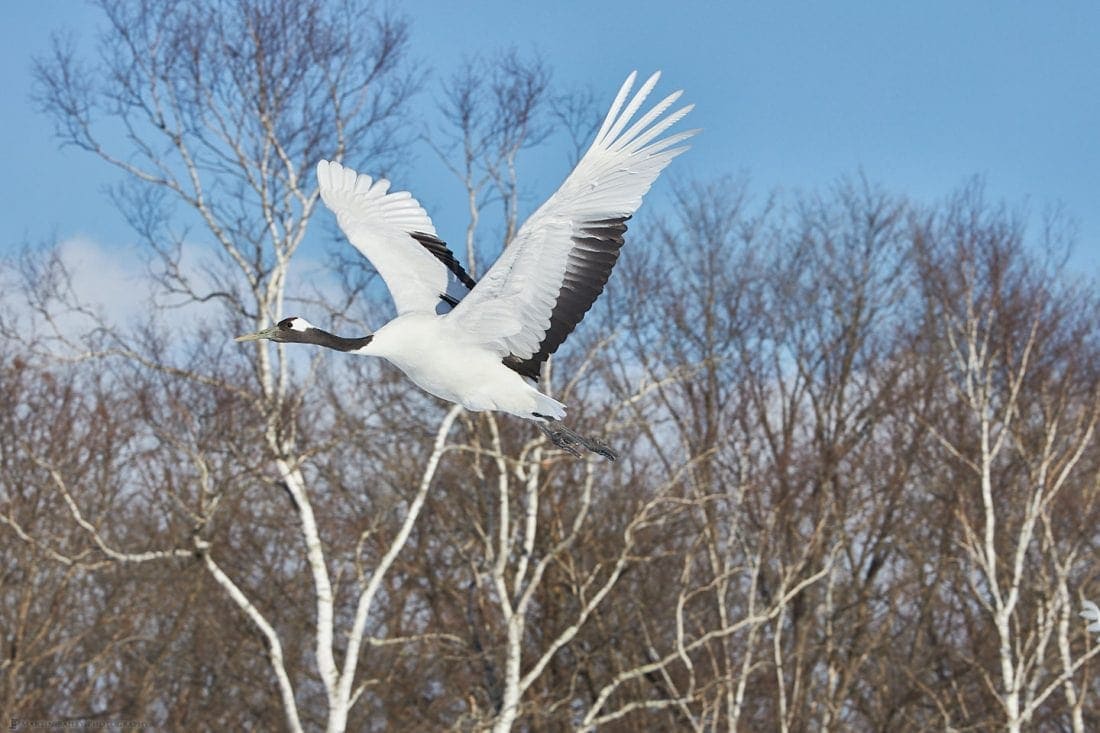
The following morning, we went back to the Otowa Bridge, and had great hoar frost again, although the mist was even stronger as it was a few degrees colder than the previous day. My photos look pretty much the same though, so I won’t share another today. After breakfast, we checked out of our lovely hotel in Tsurui and started our journey on to the Whooper Swans, then further still to photograph the Sea Eagles at Rausu, on the Shiretoko Peninsula.
As we’ve reached our ten photos for this episode though, we’ll finish there for today and conclude the Tour #1 travelogue in part two next week, before covering Tour #2 in another probably two episodes.
Japan Winter Wildlife Tours 2020
Note that we do still have some places open on the 2020 Japan Winter Wildlife Tours, so if you might be interested, please check that out here.
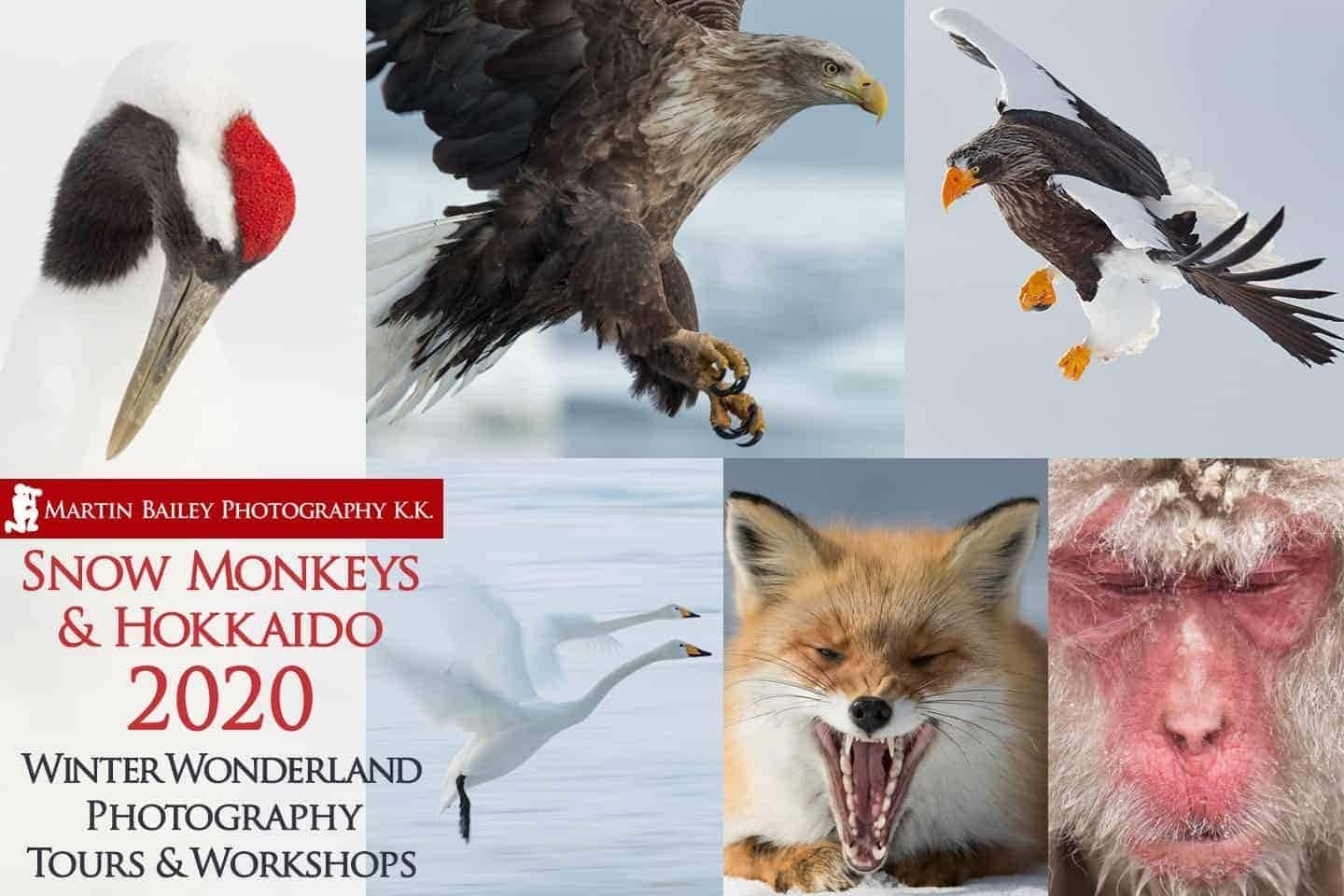
Show Notes
See details of the 2020 Japan Winter Wildlife Tours here: https://mbp.ac/ww2020
Details of all available Tours & Workshops are here: https://mbp.ac/workshops
Audio
Subscribe in iTunes to get Podcasts delivered automatically to your computer.
Download this Podcast as an MP3 with Chapters.
Visit this page for help on how to view the images in MP3 files.


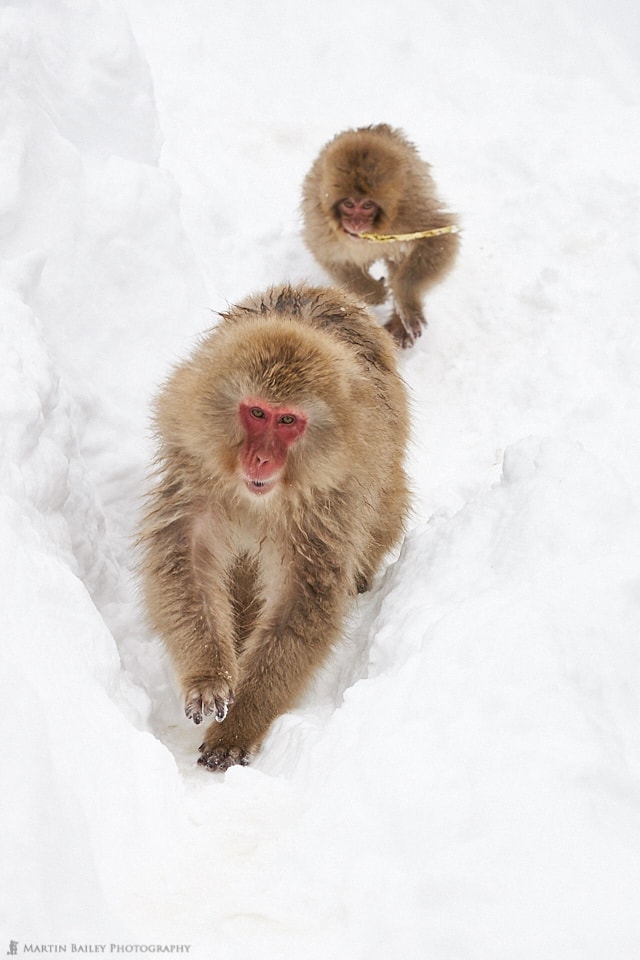



0 Comments